How Quantum Computing Reorganized a Pier
It might be hard to believe, but there are “more possible staff solutions than particles in the universe” for the typical factory, according to D-Wave Vice President of Quantum Business Innovation Murray Thom.
Yet thanks to quantum computing—or computers that employ the effects of quantum mechanics to operate more quickly and efficiently—D-Wave can help its customers solve this sort of knotty problem, whether they are trying to organize pallets, piers or people.
We spoke to Thom recently about the advantages of quantum as well as one of the company’s big successes, a collaboration with software company SavantX to increase the efficiency of Pier 300 at the Port of Los Angeles. Here’s what he had to say.
The future of computing is hybrid: When does it make sense to look beyond classical computing methods and add in quantum? As Thom explained, “Classical computers have to break things down into simpler steps—addition and multiplication.”
- However, a lot of logistical problems involve immense complexity. For example, let’s say you have boxes of components that must be shipped all over the country at different times. Thom puts it, “This box is going on this truck or that truck, [and that decision] affects other decision-making. It’s that cascade that makes this difficult for classical computing.”
- By contrast, quantum computers can take a huge volume of possible solutions, compare them all quickly and come up with a usable schedule
- Marrying classical with quantum computing—called quantum-hybrid technology—provides the best of both options and delivers robust solutions, said Thom.
The Port of LA: In 2018, SavantX was hired to improve the efficiency of Pier 300, which processes millions of containers every year.
- To juggle the many factors involved—trucks, containers and cranes that load the containers—and to model their movements inside a confined space, SavantX would need a lot of computing power. That’s why it brought in D-Wave.
- SavantX modeled the whole system using a digital twin of the pier, Thom explained. The digital twin allowed SavantX to run all types of simulations, some of which would never occur in the real world.
- Quantum-hybrid technology was then used to “ingest the whole problem” and configure it all at once “like a Rubik’s cube”—simulating an impressive 100,000 cargo-handling runs to find the best algorithm.
- And thanks to D-Wave’s proprietary cloud platform, no one at SavantX had to get “a degree in quantum physics,” Thom added. Instead, “the platform let them configure a solution, while D-Wave handled the complexity.”
Read the full story here.
Small Manufacturers Win Big with Digital Transformation

For small and medium-sized manufacturers, digital transformation can seem like an especially harrowing task. But smaller organizations can be uniquely positioned for success in implementing firmwide digital strategies.
Small but mighty: Just look at Graphicast, a 25-person precision metal parts company in Jaffrey, New Hampshire.
- “Because the cost of data collection and analytics is getting lower and lower, even as a small company we can collect data at a rate that gives us meaningful information we can act upon,” said Graphicast President Val Zanchuk. “For example, we created a linear programming model of our business. If we’re growing at a certain rate, I can use it to determine the most economical next steps, such as whether we should hire more people, work overtime or purchase more equipment.”
A workforce solution: Graphicast, which counts Fortune 100 companies among its clientele, has used cloud computing, AI-based systems and more to help it succeed, according to Zanchuk.
- The manufacturer is also looking into the use of collaborative robots as a potential solution to the labor force shortage.
- “When it comes to Manufacturing 4.0, we think about what our customers will be looking for from us in terms of digital collaboration,” said Zanchuk, adding that some of the business’s larger customers are “transforming at a different rate than we are.” That means it’s up to Graphicast to consider client expectations and see how best to meet them given “what’s financially and operationally feasible” for the company.
The MLC helps out: To aid in Graphicast’s digital transformation, Zanchuk joined the Manufacturing Leadership Council, the NAM’s digital transformation division.
- “The MLC is the only place I know where I can discuss broad industry trends in an open fashion, where small companies like mine and large companies like Ford or GM can all be involved in the discussion,” said Zanchuk, who serves on the MLC Board of Governors.
- “Being part of the MLC lets us know if we’re on the right track and how we can make adjustments,” he continued. “It connects us to a group of incredibly talented, intelligent and experienced people who are focused on many of the same operational challenges we face.”
A FAME Student Finds His Place at Electrolux Group
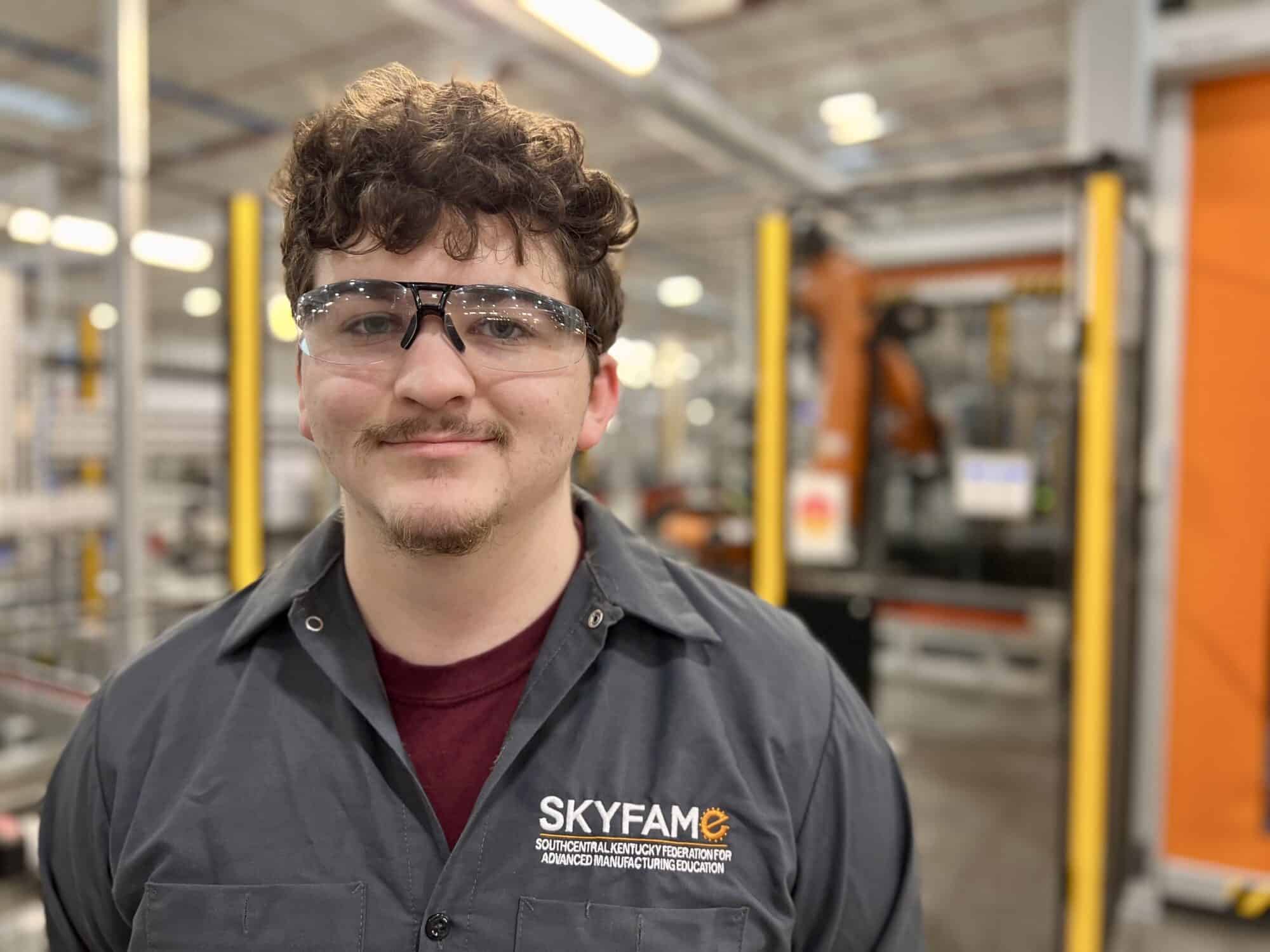
From the first moment Caleb Cleveland visited Electrolux Group—a home products and appliance manufacturer in Springfield, Tennessee—he knew it was the place for him.
“I knew I wanted to work with my hands,” said Cleveland. “I didn’t want to be sitting at a desk in front of a computer screen. I loved this place from day one.”
Cleveland found Electrolux Group through the Federation for Advanced Manufacturing Education program, or FAME, which his guidance counselor recommended to him. Today, both he and his employer are thrilled he’s taking part.
The program: Founded in 2010 by Toyota and operated today by The Manufacturing Institute, FAME aims to help students become highly skilled, sought-after workers capable of meeting the unique needs and challenges of the modern manufacturing sector.
- It provides current and aspiring workers with on-the-job training and classroom education, leading to an associate degree and the FAME advanced manufacturing technician certificate.
- “This program is one of a kind,” said Cleveland. “I’m actually getting paid to go to school. I’m getting the classroom and training classes here at Electrolux Group. I’m learning from people at school and from experts here.”
The benefits: At a time when manufacturers are struggling with record high job openings and a lack of skilled workers, FAME is helping to bring in a new generation of employees.
- Cleveland will be the Electrolux Group’s first graduate of the program when he completes it in May 2024, and the company sees his success as both a point of pride and an investment in the future of manufacturing.
- “We are committed to continuous upskilling of our current workforce and this is a strong pipeline for new talent with digital skills,” said Electrolux Group Senior Manager of Learning Dan Caldwell. “Part of our strategy is to partner with the FAME program so we can not only bring in Caleb with his classroom knowledge, but also help him to learn and grow.”
Changing minds: FAME is also helping to improve perceptions of the manufacturing industry among young people.
- “In the past, manufacturing has had a dark and gloomy reputation, and we are changing that perspective,” said Electrolux Technical Trainer Eric Drake. “We want up-and-coming talent to know that there are people in manufacturing who care about their future and want them to succeed. We’ll provide the stepping stones for their journey.”
Off to a great start: According to Caldwell and Drake, Cleveland has been an enormous asset for the company already.
- By the end of his first semester, he was able to step in and do most of the work of a process technician, filling in at a time when the company was shorthanded.
- “Caleb is doing a knockout job,” said Drake. “Our objective is to make opportunities available for him.” Caldwell added, “We are incredibly proud of Caleb with the initiative he takes.”
The bottom line: “The program has exceeded my expectations,” said Cleveland. “When I first started I was worried about being seen as that intern who sticks to somebody’s hip. But at Electrolux Group, I found my own place.”
Announcing the 2023 Manufacturing Leadership Award Finalists!

The Manufacturing Leadership Council—the NAM’s digital transformation division—has announced the finalists for the 2023 Manufacturing Leadership Awards, the industry’s premier awards program for achievements in digital manufacturing. You can read the complete list of finalists here.
The ceremony: The finalists will be honored at the Manufacturing Leadership Awards Gala in Marco Island, Florida, on June 28.
- Also announced at the gala will be winners for all project and individual categories, winners of the Manufacturing in 2030 Award, the Manufacturing Leader of the Year, the Small/Medium Enterprise Manufacturer of the Year and the Large Enterprise Manufacturer of the Year.
Rethink: Certain award winners will also present at Rethink, the industry’s leading event for exploring manufacturing’s digital era, which will also take place in Marco Island on June 26–28.
The categories: The awards are divided into nine project categories to recognize company achievements:
- Artificial Intelligence and Machine Learning
- Collaborative Ecosystems
- Digital Network Connectivity
- Digital Supply Chains
- Engineering and Production Technology
- Enterprise Technology Integration
- Operational Excellence
- Sustainability and the Circular Economy
- Transformational Business Cultures
Additionally, individual leaders are recognized in the Digital Transformation Leadership and Next-Generation Leadership categories.
The last word: “As more manufacturers extend digital’s reach onto the factory floor and throughout their operations, we are witnessing transformative performance improvements that would have been unthinkable just a few short years ago—and that are improving life for employees and customers alike,” said MLC Co-Founder, Vice President and Executive Director David R. Brousell.
A GM Engineer Follows in Her Parents’ Footsteps
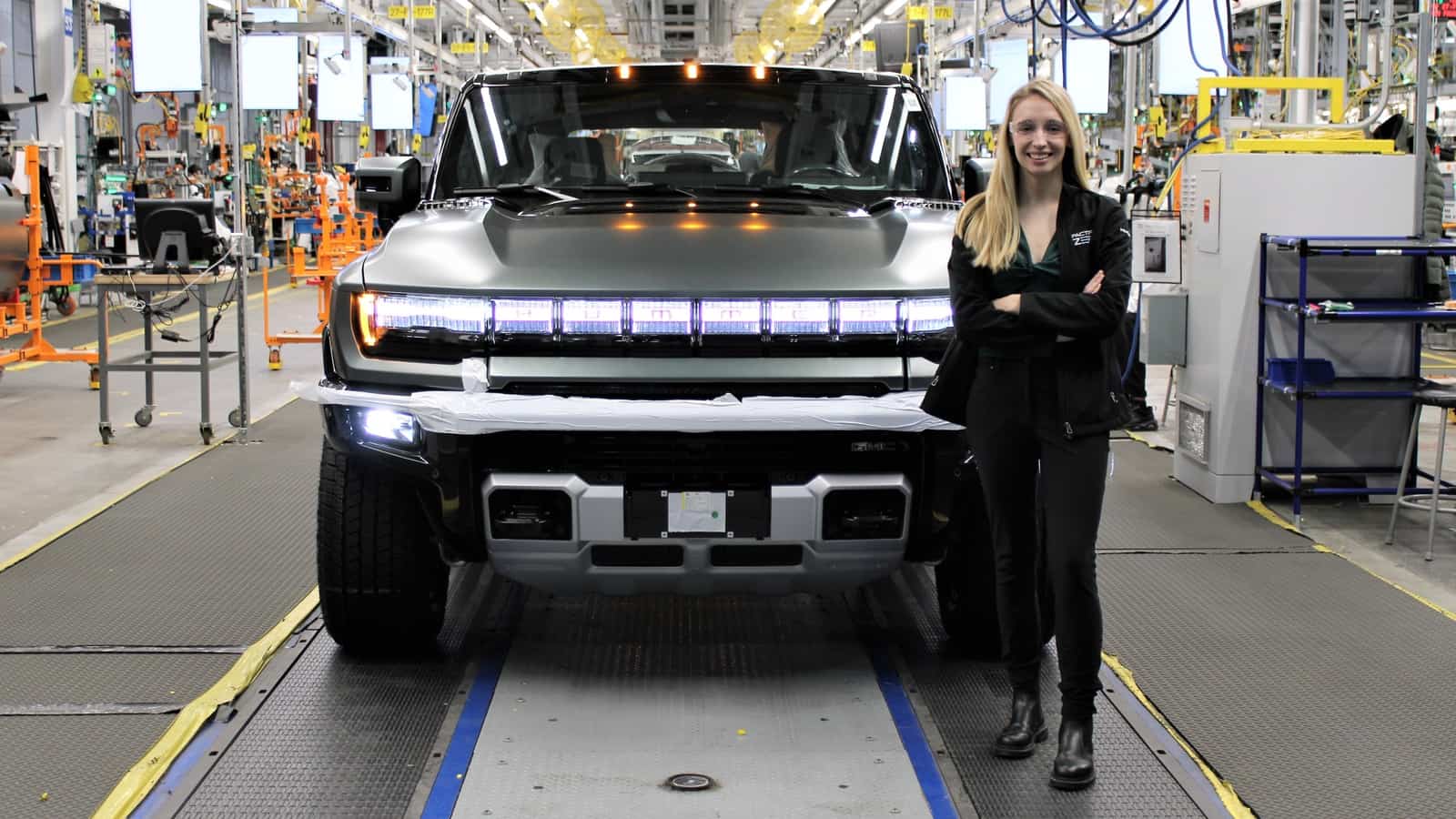
Alison Holland was almost predestined to be an engineer at General Motors. Born to an electrical engineer mother and a mechanical engineer father, both of whom work at GM, she grew up entirely familiar with the discipline and the company.
Today, she’s working to establish GM’s first-ever assembly operations for a new EV battery platform at Factory ZERO in Detroit-Hamtramck, Michigan. Recently named an Emerging Leader by the Manufacturing Institute’s 2023 Women MAKE Awards, which honor outstanding women in the industry, Holland spoke to us about her career, her work helping other young women find their footing and her goals for the future.
Not your mother’s industry: As the daughter of a female engineer, Holland has a unique perspective on the role of women in the industry. How was her mother’s experience different from her own?
- Women were much more in the minority back then, Holland said, and her mother “had to work even harder to earn her way to the top.”
- Holland learned a great deal about managing her own career from her mother, a kind, patient parent who never missed her four children’s activities or let the pressures of work invade her home life.
Choosing manufacturing: While her parents’ example set her on the path toward manufacturing, Holland also attributes her comfort in the industry to her competitive nature.
- The former college soccer player says manufacturing has a similar feel to sports and is rewarding for those who want to excel in a “high-paced” environment.
- “I wanted a career where I could be challenged and see my efforts pay off with real-time results”—just as she did on the field.
A sustainable career: At GM, Holland is part of an exciting project: launching GM’s first battery assembly plant under the same roof as EV truck assembly at Factory ZERO. The battery, or Rechargeable Energy Storage System, is based on GM’s Ultium battery platform, which will increase the range, power and performance of a number of different vehicle types. She works with coordinators and engineers at different sites, making sure best practices are codified and shared throughout the company.
- Holland loves her work because “it’s a new challenge every day. I’m helping to reinvent the wheel when it comes to battery production. The small decisions we make will have a long-lasting impact.”
A young leader: Holland considers herself lucky to have had excellent female mentors, who helped her learn to “make her opinions heard.” Today, she helps other people, including many women, find support for their own goals.
- As part of GM’s early career development program for manufacturing engineers, Holland organized events like lunch-and-learns so that young workers could hone their professional skills together and build productive relationships. She also helped participants find and benefit from mentors who previously went through the program.
- Holland also provides coaching to women who are experiencing professional “firsts”—such as the first time they work on the production line, or encounter a new process, or lead teammates with unique backgrounds. Holland began this work while serving as a mentor in the early career development program and has kept it up as she leads her own team.
What’s next? When Holland looks ahead, all she sees are opportunities. “I am super interested in sustainability. I want more experience in other production departments, so I can understand all the other sides of the business. I want to have more cross-functional experiences, so I can better understand what people are asking of me.”
The last word: Holland has simple but important advice for young women starting out in the industry. “Learn as much as you can. Take any opportunity to learn about the industry. That will boost your confidence. It takes some time and you’ll make some mistakes, but all of those experiences matter.”
Timmons Talks Trade, Economy and Jobs
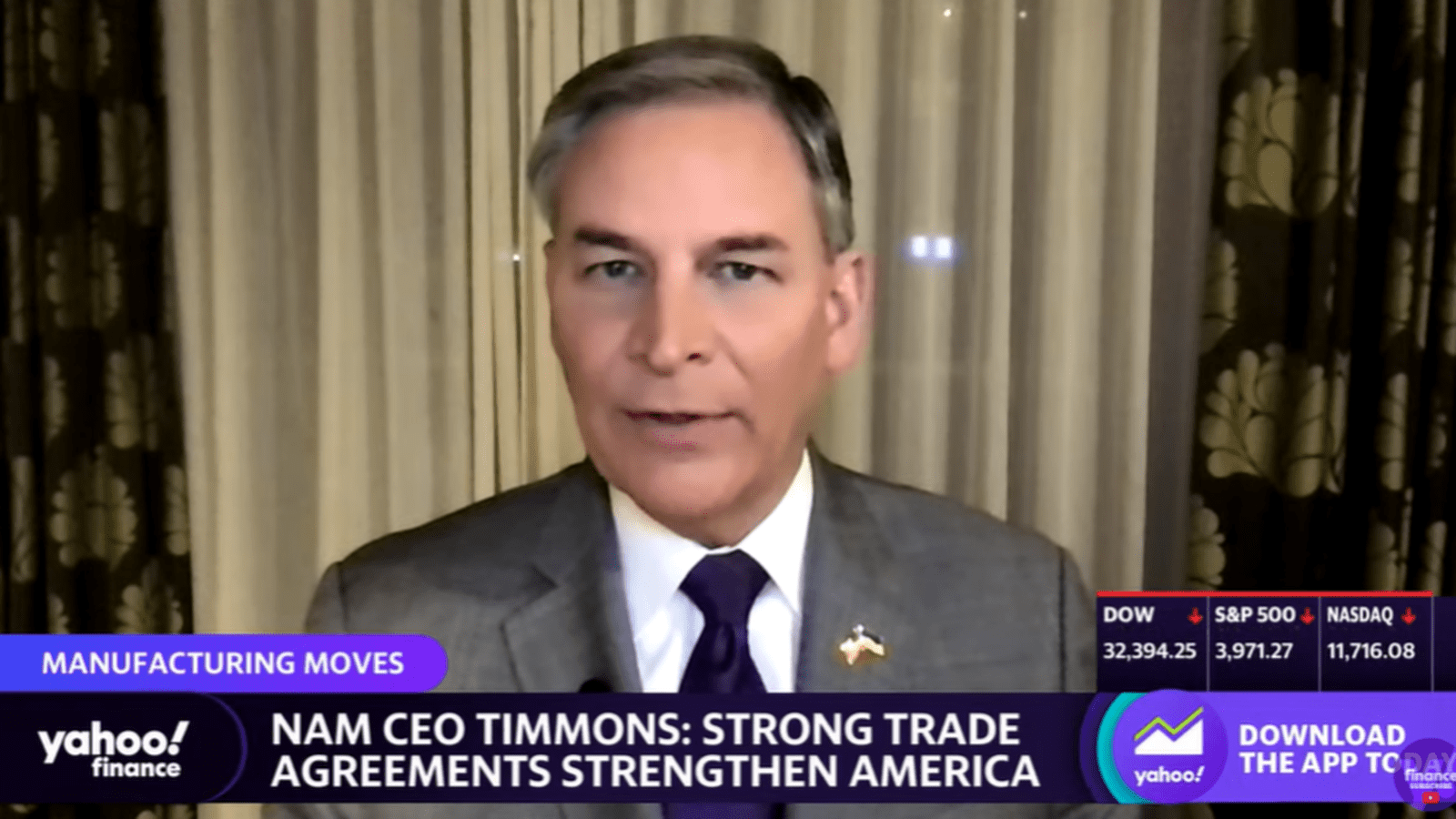
Solid international relationships will see us through any crisis, and artificial intelligence will add jobs to manufacturing, not remove them. Those were just two of the messages driven home by NAM President and CEO Jay Timmons during a Yahoo! Finance interview this week.
- Timmons gave the interview after a busy few days in London as part of the Competing to Win Tour in Europe, where he met with U.K. leaders and the U.S. ambassador to discuss strengthening the U.S.–U.K. alliance.
Trade deal needed: To ensure future manufacturing competitiveness, the U.S. needs a “robust agenda” from the Biden administration—now, said Timmons.
- “We haven’t seen a trade deal negotiated in our country or with our country for four presidencies,” continued Timmons. “We’re growing manufacturing in the United States thanks to the 2017 tax reforms, thanks to the infrastructure investment legislation, thanks to the CHIPS and Science Act.”
- “But … 95% of the world’s customers live outside of the United States. And we can strengthen our supply chains and we can also sell our products if we have the right trade agreements in place.”
Uniting to solve problems: Reinvigorating historic alliances is crucial to overcoming “any obstacle,” said Timmons.
- “[W]e want to make sure that our allies are … able to work together to solve some of these big macroeconomic issues, whether it’s a banking crisis or whether it’s increasing trade opportunities,” Timmons said.
AI: Meanwhile, AI will only expand and improve workers’ jobs, not replace human beings, Timmons said.
- AI is “going to [have] an incredibly positive impact on the sector because it is going to enhance manufacturing capability and output and it’s going to be a supplement to jobs all across the world,” Timmons said.
- “Think about all the technological advances we’ve had over the course of the last few decades, but especially the last five to 10 years. All of these advances have given additional capabilities to the workers.”
Filling jobs: Also needed is a strong workforce. Timmons discussed some of the findings of the NAM’s test Manufacturers Survey, in which nearly 75% of manufacturers cited attracting and retaining quality employees as a top challenge.
- He touched on some of the many initiatives of the Manufacturing Institute, the NAM’s 501(c)3 workforce development and education affiliate, to shore up labor force participation. These include second chance hiring, Creators Wanted—which seeks to inspire tomorrow’s workforce—and more.
The last word: “And that takes this full circle,” Timmons said. “Young people are learning new skills when it comes to technology. Robotics, artificial intelligence, augmented reality, all of those things are what modern manufacturing is all about. And the next generation are the ones that are going to deliver for us.”
The NAM Talks Democracy, IP and Trade in Geneva
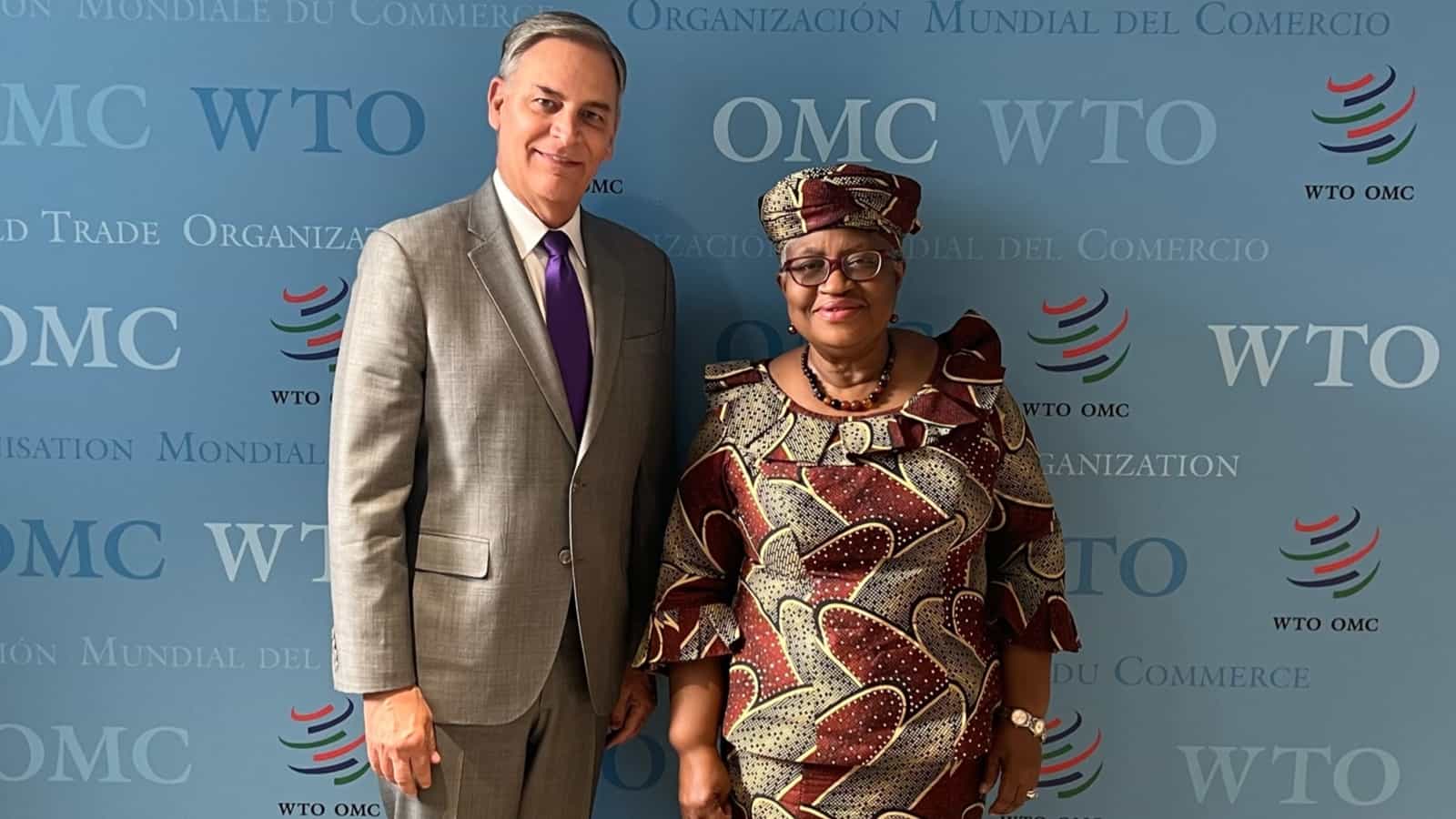
On the first two days of the NAM’s Competing to Win Tour in Europe, Timmons took part in “frank and engaging” discussions with global leaders in Geneva. The conversations focused on reinforcing transatlantic partnerships, bolstering democracy, addressing trade challenges and emphasizing the crucial role manufacturers play in promoting global stability.
The details: Timmons met with influential figures including WTO Director-General Dr. Ngozi Okonjo-Iweala, WTO Deputy Director General Angela Ellard, U.S. Ambassador to Switzerland and Lichtenstein Scott Miller and U.S. Deputy Chief of Mission in Geneva David Bisbee.
- NAM representatives also participated in an event on intellectual property co-hosted by the NAM and the International Federation of Pharmaceutical Manufacturers and Associations.
The substance: In the meetings, Timmons delved into the negative impact of the WTO/TRIPS waiver expansion, the need to restore the WTO dispute settlement system’s functionality and the crucial role of manufacturers in supporting democracies and global institutions.
- ‘“Frank & engaging discussion w/ @JayTimmonsNAM CEO of the US National Association of Manufacturers & his delegation. Focused on geopolitical tensions & impact of @wto, challenges w/ the TRIPS waiver extension to therapeutics & diagnostics, dispute settlement system & road to #MC13 [the WTO’s next ministerial conference in early 2024],” tweeted Okonjo-Iweala following the meeting.
Speech in brief: At the IFPMA event, first covered by Politico, Timmons stressed the significance of IP protections in driving innovation and developing new treatments, reinforcing the NAM’s opposition to an expansion of the TRIPS waiver to cover diagnostics and therapeutics. Attendees included Geneva-based government delegations, the WTO secretariat and NAM member companies.
- “In America, our industry works to advance the values of free enterprise, competitiveness, individual liberty and equal opportunity—the values that keep our industry strong,” said Timmons. “But increasingly, we find these values, which so many of us share, under attack—in particular from authoritarian regimes that have little regard for free markets and little respect for an individual’s right to determine their own destiny. That’s why our transatlantic relationship matters more than at any time in recent memory.”
- “[O]ne of the most important ingredients for innovation is how a country protects intellectual property. IP enshrines the understanding that years or even decades of hard work and sleepless nights, millions and millions of dollars and so much more will be rewarded,” he continued.
- “Expanding this [WTO/TRIPS waiver of IP] would set a precedent that would spiral across the manufacturing sector,” he concluded. “Some voices—here in Geneva and around the world—are already expressing desires to implement similar waivers for renewable and green energy technologies, or to automatically trigger an IP waiver for any future pandemic. If we don’t draw the line now, the outcome is obvious: an anti-innovation domino effect that destroys jobs, livelihoods and lifechanging products.”
The big picture: More than a worldwide center for diplomacy, Switzerland is the seventh largest investor in the U.S. Timmons’s visit comes at a critical inflection point for the country and amid heightened stresses on global institutions, due to COVID-19, Russia’s unprovoked war in Ukraine and competition with China, among other geopolitical challenges.
News coverage: Politico’s Morning Trade newsletter spotlighted Timmons’s trip, while The Wall Street Journal (subscription) quoted him on the importance of new U.S. trade agreements.
Next up: The tour will continue in Frankfurt, Germany, where the NAM will further demonstrate manufacturers’ leadership and the potential for a more robust transatlantic alliance.
Senators Reintroduce Crucial R&D Bill
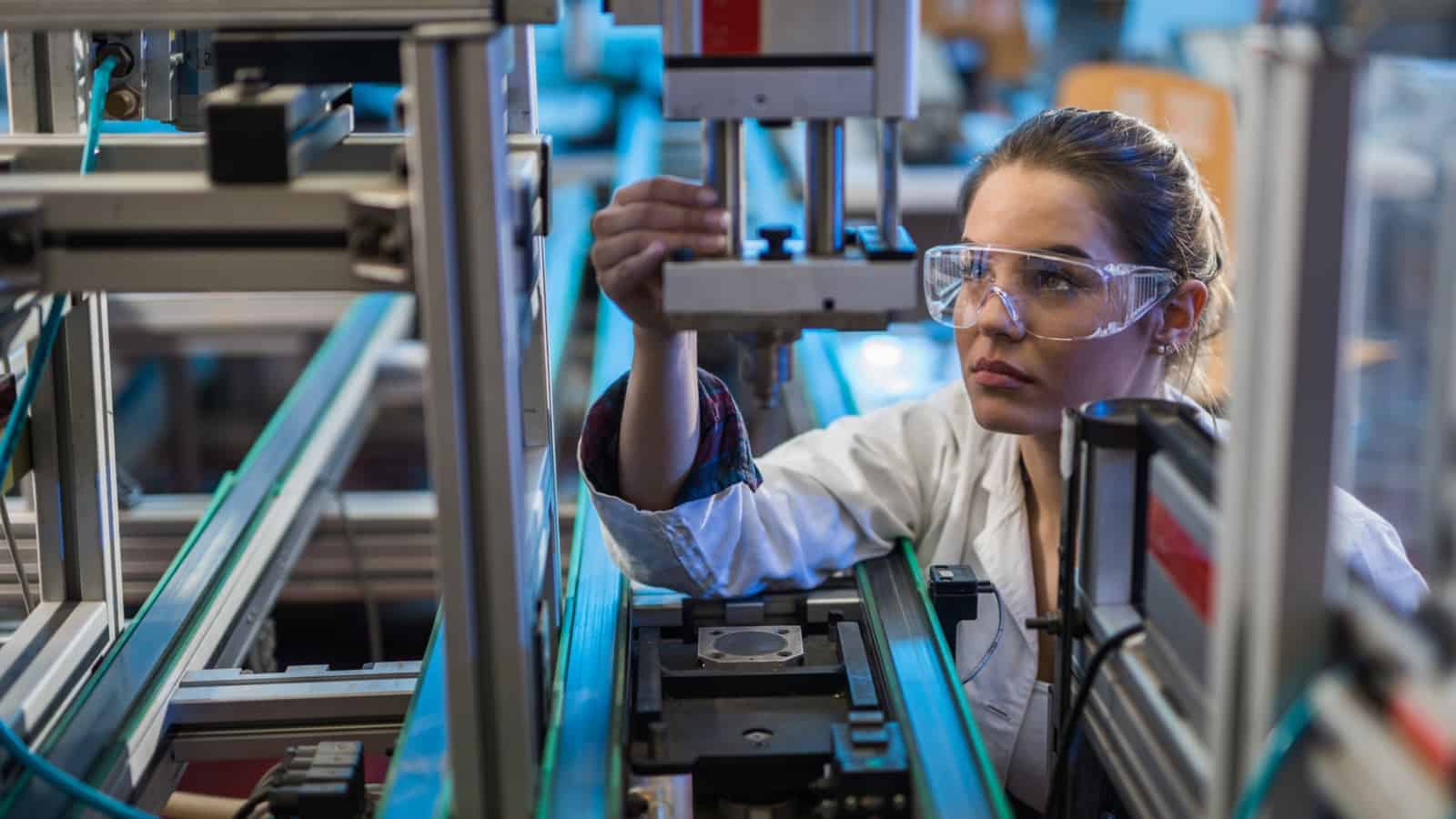
A bipartisan Senate duo introduced legislation on Thursday that would both allow businesses to once again fully deduct R&D expenses in the year they are made and expand the refundable R&D tax credit.
What’s going on: The American Innovation and Jobs Act, sponsored by Sens. Maggie Hassan (D-NH) and Todd Young (R-IN), would restore the immediate deductibility of R&D expenses. Last year, a tax change went into effect requiring companies to amortize or deduct their R&D investments over a period of years, making R&D more costly.
Why it’s important: According to a recent NAM analysis, the sector would lose nearly 60,000 jobs and face an output decline of more than $31 billion this year alone if the change is not reversed.
- The U.S. has now become a global outlier, joining Belgium as the only other developed country requiring the amortization of R&D expenses.
- Meanwhile, China provides a 200% “super deduction”—20 times the amount allowed in the U.S. tax code—for its manufacturers’ research.
The NAM says: “Manufacturers applaud the introduction of the American Innovation and Jobs Act, which will help the U.S. out-compete China,” said NAM Managing Vice President of Tax and Domestic Economic Policy Chris Netram.
- “Across the country, manufacturers are hiring workers, investing in communities and creating the products, materials and processes that drive us forward. Congress should approve the American Innovation and Jobs Act quickly to support critical research that allows manufacturers to improve lives in America and for people around the world.”
Learn more: Read our stories on how the 2022 expensing requirement is impacting International Paper, Marlin Steel Wire Products, Ultragenyx, Miltec UV and Brewer Science (whose story was also covered today by The Wall Street Journal, subscription).
Sens. Hassan and Young Reintroduce Crucial R&D Legislation
American Innovation and Jobs Act will ensure that the tax code supports the ability of manufacturers to out-compete China and create well-paying jobs
Washington, D.C. – Following the introduction of the American Innovation and Jobs Act by Sens. Maggie Hassan (D-NH) and Todd Young (R-IN), National Association of Manufacturers Managing Vice President of Tax and Domestic Economic Policy Chris Netram released the following statement:
“Manufacturers are hiring workers, investing in communities across the United States and creating the products, materials and processes that drive America forward. Manufacturers applaud the introduction of the bipartisan American Innovation and Jobs Act, which restores full deductions for research, helping the American industry out-compete China, which provides a 200% super deduction for manufacturers’ research—20 times the amount in the U.S. tax code,” said Netram. “Manufacturers, the vast majority of which are quite small, perform 55% of private-sector research and development. These investments in innovation spur economic growth and support the creation of high-paying jobs across the country. Congress should approve the American Innovation and Jobs Act quickly to support critical research that allows manufacturers to improve lives in America and for people around the world.”
Background: As of 2022, manufacturers can no longer immediately deduct their R&D expenses in the year in which they are incurred. Instead, manufacturers must deduct or amortize their expenses over a number of years, which makes R&D much more expensive to undertake. The American Innovation and Jobs Act would restore the immediate deductibility of R&D expenses, a policy that was in place for nearly 70 years. In the 117th Congress, the American Innovation and Jobs Act garnered 35 cosponsors: 17 Democrats and 18 Republicans. A recent analysis released by the NAM finds that the industry would lose 59,392 jobs and face a decline in output of $31.69 billion this year if Congress does not act.
-NAM-
The National Association of Manufacturers is the largest manufacturing association in the United States, representing small and large manufacturers in every industrial sector and in all 50 states. Manufacturing employs nearly 13 million men and women, contributes $2.81 trillion to the U.S. economy annually and accounts for 55% of private-sector research and development. The NAM is the powerful voice of the manufacturing community and the leading advocate for a policy agenda that helps manufacturers compete in the global economy and create jobs across the United States. For more information about the NAM or to follow us on Twitter and Facebook, please visit www.nam.org.
A Young Engineer Makes Herself Heard in Manufacturing
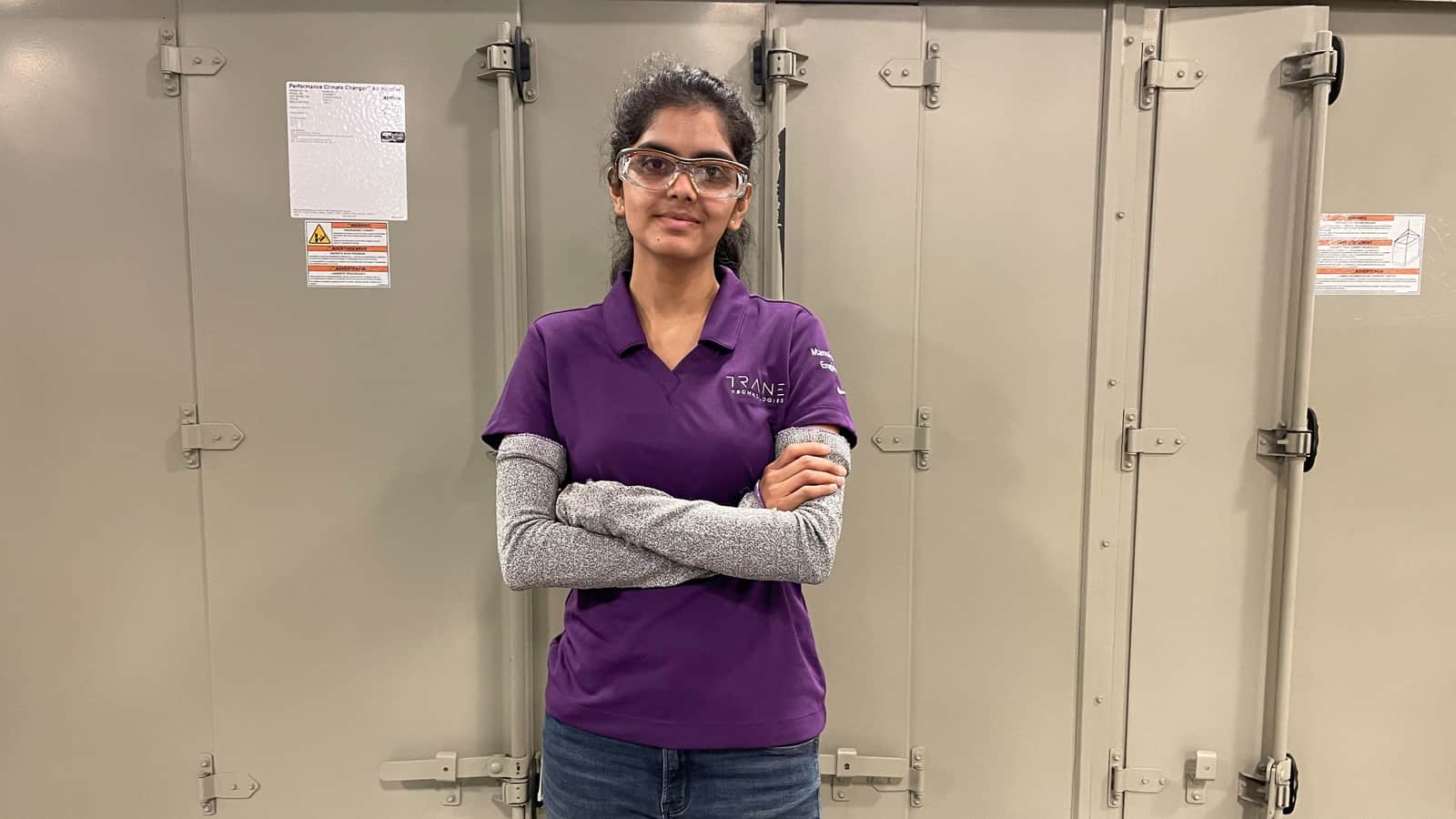
Rashmi Vadlakonda is a woman with a voice, and she’s not afraid to use it.
As a manufacturing engineer at Trane Technologies—a company focused on sustainable climate innovations—Vadlakonda is making advancements in engineering and paving the way for more women of color to join her. That’s why she was recently recognized by the Manufacturing Institute’s 2023 Women MAKE Awards as an Emerging Leader.
The award: The Women MAKE Awards, formerly known as the STEP Ahead Awards, honor top female talent in the industry while providing honorees with a platform to inspire other future industry leaders. Vadlakonda sees the honor as an opportunity to keep speaking up for people who are underrepresented.
- “I believe that for young women in manufacturing, especially for me as an immigrant young woman of color … a title helps,” said Vadlakonda. “This award gives me that title [and] the courage that I need to speak up and say, ‘Hey, I have something to share, and I want you to listen to me. There’s a reason I was recognized.’”
Starting out: Vadlakonda wasn’t immediately drawn to engineering, but when she was growing up in India, it was typical for young people to pursue engineering or medicine.
- Once she “fell into it,” she loved it, and took an especially strong interest in 3D printing while in graduate school at North Carolina State University. Her passion for 3D printing is what brought her to Trane Technologies.
Making the transition: When she first came to the company, she was responsible for operationalizing additive manufacturing throughout the company.
- She spent a few years in a corporate setting, traveling to different offices and introducing advanced manufacturing technologies—but when the pandemic hit and travel was largely suspended, she had plenty of time to think about what she wanted to do next. That’s when she decided to pivot to working in a factory setting.
- “The factory is a basic building block of the manufacturing industry,” said Vadlakonda. “Coming from a research background, I wanted to understand how a factory functions, how the people there think, how different groups interact with each other, and what it takes to actually deliver a good product.”
The factory floor: Vadlakonda is grateful she got a chance to work in both the corporate and factory environments. In a factory, she says, the pace is much faster, and you’re pushed to solve problems right in front of you. This was a challenge she found thrilling.
To women in the industry: When asked what her advice is for women in the industry, Vadlakonda first had advice for industry leaders. She believes they must create a comfortable environment for people from all walks of life.
- “Sure, you can get someone interested in manufacturing, you can help them come into the industry,” said Vadlakonda. “But we also have the responsibility of creating a welcoming environment where they feel like they can grow, so that they don’t leave, so that they’re happy here in the industry.”
The future: Vadlakonda, who is a champion of, and volunteer for, the industry’s Creators Wanted campaign to inspire the next generation of creators, believes it is vital that young people are exposed to manufacturing career options at an early age.
- “It doesn’t start with talking to women who have decided on a career path,” said Vadlakonda. “You have to start with kids. That’s why I like talking at Creators Wanted. Young people are naturally attracted to what they’re attracted to. Our job as adults is to help them see the options.”
The last word: “Manufacturing is very exciting,” said Vadlakonda. “It’s very interesting, you get to be creative and solve problems—and it’s such a satisfying feeling to solve problems.”